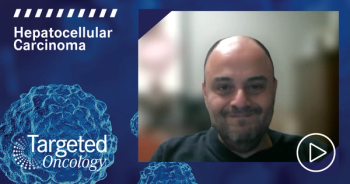
Case 2: Selecting Frontline Therapy for Metastatic HCC
Focused discussion on the frontline treatment options available for patients diagnosed with metastatic hepatocellular carcinoma.
Episodes in this series

Transcript:
Ghassan K. Abou-Alfa, MD: Let’s move on to what Dr Singal just brought up: the type of diseases and what he referred to as being BCLC-C [Barcelona Clinic Liver Cancer stage C]. In oncology, we refer to them as AJCC [American Joint Committee on Cancer] stage IV, Child-Pugh A. We heard that the patient had varices because of cirrhosis. They were treated 2 months ago, and she has Crohn disease, which appears to be under control. There are many options of therapy available. Based on the guidelines presented so far in the NCCN [National Comprehensive Cancer Network], we have atezolizumab-bevacizumab. We have also sorafenib and lenvatinib. In addition, we’ve added information in regard to durvalumab based on the HIMALAYA study and in regard to pembrolizumab. These are based on the KEYNOTE studies. In addition, there’s nivolumab, which we’ll discuss in a bit and see everyone’s thoughts on, and the HIMALAYA study, which speaks to durvalumab-tremelimumab. I’ll start with Dr Yarchoan. Please tell us a little more about your best understanding, and we’ll start with the 1 that remains in a very unusual situation: nivolumab. They already voluntarily withdrew their approval request by the FDA, but they’re still hanging in the FDA in the NCCN Guidelines because this is an unusual circumstance, especially for Child-Pugh B. What are your thoughts?
Mark Yarchoan, MD: My thoughts about single-agent PD-1 in frontline—is that what you’re asking for?
Ghassan K. Abou-Alfa, MD: Your thoughts about nivolumab as single-agent treatment, considering that the company did withdraw its approval but is still hanging in the NCCN as a Child-Pugh B.
Mark Yarchoan, MD: There’s still a role for anti–PD-1 or anti–PD-L1 monotherapy.
Ghassan K. Abou-Alfa, MD: I’m not talking about anti–PD-1 or anti-PD-L1. I’m talking about nivolumab.
Mark Yarchoan, MD: As many folks know, nivolumab was studied against our old standard of care, sorafenib, in the frontline setting with the CheckMate 459 study. Many of us were very hopeful that this would be a positive study. Unfortunately, it missed its superiority end point with a P value of .07. Everything went in the right direction, but it wasn’t enough to show superiority over sorafenib. I like that we have the ability to use this agent in select cases. It’s clear that this agent is well tolerated. It seems to be safe and have real activity. If this was set up as a noninferiority study, I strongly suspect that it would have demonstrated noninferiority. In fact, durvalumab—
Ghassan K. Abou-Alfa, MD: Which we saw, to be fair. I totally agree.
Mark Yarchoan, MD: Durvalumab clearly showed noninferiority.
Ghassan K. Abou-Alfa, MD: Which we saw. I agree. If anything, durvalumab wasn’t an inferiority, and it showed it. You’re absolutely right.
Mark Yarchoan, MD: The hazard ratios are basically the same: 0.585 and 0.86. Now that durvalumab has been added—it’s a technically positive study and met its noninferiority end point—I don’t know that we need nivolumab anymore.
Ghassan K. Abou-Alfa, MD: Thanks, Mark. Let’s carry on with Amit on that. Amit, Dr Yarchoan diplomatically was stating that the nivolumab study was an active study. To give credit, the decision made to withdraw it was totally appropriate, but our biggest takeaway was that we need a combination therapy; an anti–PD-1 or an anti–PD-L by itself isn’t enough. Maybe the only thing that we have positive now is durvalumab in noninferiority because it was designed as such. At the same time, we have pembrolizumab approved in second line as well, even though the study standing toward negative. Atezolizumab-pembrolizumab is so far the preferred regimen until we see what’s going to happen with durvalumab-nivolumab because it’s not approved. What did we see about this 75-year-old patient with the varices and the Crohn disease that makes you think about your choice of therapy? I’d like to see your perspective as we approach to that.
Amit Singal, MD: When we think of first-line therapies, atezolizumab-bevacizumab is the preferred therapy for patients in the frontline setting, given superiority vs sorafenib in the IMbrave150 trial. When we look at the patient’s selection for the IMbrave150 trial, we have to remember that patients were required to undergo an upper endoscopy. Patients with a high risk of stigmata for vitreous bleeding or recent vitreous bleeding weren’t included in that study until they had their varices under control. Unfortunately, beauty is in the eye of the beholder in terms of varices being under control and that patient having a manageable risk of bleeding. In our specific patient, the recent varices bleeding 2 months ago would at least give me pause.
Of course, with immune checkpoint inhibitor therapy, you can have other autoimmune off-target effects. It seems like her Crohn disease is well controlled on her therapy. I’d be less concerned about Crohn disease, but there are building blocks—we have a couple of things that would give me pause in this patient. In terms of atezolizumab-bevacizumab in this patient, the variceal bleeding would make me pause a little more than her Crohn disease. But between the 2 of them, I’d strongly consider TKI [tyrosine kinase inhibitor] therapy, whether sorafenib or lenvatinib, in this patient. It’s nice to have options, because subsets of patients will not be optimal candidates for atezolizumab-bevacizumab.
Ghassan K. Abou-Alfa, MD: That’s a great analysis that you brought up. There’s no doubt that these concerns are unfortunately seen on this patient in regard to the Crohn disease and the varices, which are only 2 months old. That is your introduction toward TKIs. Dr Yarchoan, regarding lenvatinib and sorafenib, what are your thoughts?
Mark Yarchoan, MD: More and more, we’re excited about doublets.
Ghassan K. Abou-Alfa, MD: No. We’re talking about lenvatinib or sorafenib. Remember, we agree that we’re going to do a TKI now.
Mark Yarchoan, MD: Between the 2 of them, we know that lenvatinib is noninferior in terms of survival. It seems to be more potent than sorafenib and demonstrates superiority with certain secondary end points, some of which actually matter. Response rate does matter, and PFS [progression-free survival] does matter. At low doses, lenvatinib is very tolerated. It seems to have less hand-foot syndrome, which is the most problematic adverse effect to sorafenib. Both of them are very reasonable options, but lenvatinib does have certain attributes that make it favorable.
Transcript edited for clarity.










































